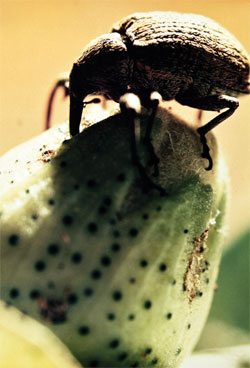The Bug That Changed the South
AU Professor Chronicles Boll Weevil’s History in Alabama

It struck with a vengeance, driving thousands of poor Southern farm families out of their meager livelihoods and exacting a heavy toll on the South’s ravaged post-Civil War economy.
Paradoxically, though, the struggle to contain and eradicate it ultimately brought immense benefits to the South.
"It" was the boll weevil, a bug that still influences the South today.
"We really don’t know of any other agricultural pest that has had the impact of the boll weevil," says Ron Smith, an Alabama Cooperative Extension System entomologist and AU emeritus professor of entomology.
"There are a lot of historians who feel that when you look at the religion, politics, law and art of the South, the boll weevil may have exerted a greater influence on all of these things than any factor except the Civil War."
Whatever the case, the legacy of this tiny insect likely will command a prominent mention in histories of the South for decades, if not centuries, to come, says Smith, who recently completed an Alabama Agricultural Experiment Station bulletin (Bulletin 670) covering the history of boll weevil eradication in the state from 1910 to 2007.
The weevil entered the United States from Mexico in 1892. In less than 30 years, Southern farms were reeling from its effects.

In 1917, the first year the weevil was detected throughout the state, cotton planting declined by more than a million acres from previous years. By 1955, the pest had caused an average annual loss to Alabama cotton producers of $200 million. Yearly economic losses associated with the weevil in Alabama totaled between $20 million and $40 million for more than 80 years.
Farmers experimented with many different methods to control the pests, but none of them proved effective.But an emerging cadre of scientists and educators at Southern land-grant universities began working on solutions, many of which are still felt today in ways their creators never imagined, Smith says.
These included diversified agriculture, development of the Cooperative Extension concept, the rise of entomological science in the South and a host of advances in all facets of agricultural science, some of which have had lasting influences on other scientific disciplines and technologies.
The effective elimination of the boll weevil from Southern cotton fields is an achievement that, in turn, has resulted in lower insecticide uses and significant changes in the cotton insect spectrum, Smith says.
To obtain a copy of the bulletin, go to www.ag.auburn.edu/aaes and click on publications, or call 334-844-4877.
